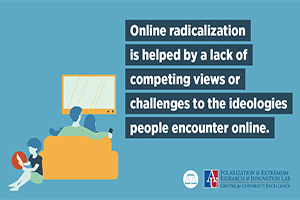Research
In the COVID-19 era, Parents Must Be Alert to Online Radicalization. A New Guide Can Help.

With the COVID-19 pandemic and in this time of social unrest, experts say extremists are taking advantage of fear and uncertainty surrounding the virus and recent events to radicalize youth online. A new guide from American University’s Polarization and Extremism Research and Innovation Lab, or PERIL, in collaboration with the Southern Poverty Law Center, provides resources to help parents and caregivers.
“The only long-term solution to interrupt the growth of far-right extremism is sustained education — in schools, at home, in religious communities, sports teams, and anywhere youth gather,” said Cynthia Miller-Idriss, professor of education and sociology and director of research at PERIL. “But right now, youth are at home with parents and caregivers and spending more time online. In the absence of networks of trusted adults and peers, youths become targets for the far-right, who promise easy answers about who youth can blame for their plight.”
In the United States, domestic terrorism, including home-grown extremist activity and the beliefs of white supremacy, presents a greater threat to the public than any other form of extremism or terrorism, including Islamist terrorism. In 2019, domestic extremists killed at least 42 people in the United States in 17 separate incidents, according to the Anti-Defamation League, making 2019 the sixth deadliest year on record for domestic extremist-related killings since 1970.
Not every person who espouses extremism will turn to killing, and there’s much that science has yet to reveal about what makes a person turn from engaging in extremist activity to carrying out extremist violence, Miller-Idriss said. Working with scholars, teachers, parents, and even former extremists, the team at PERIL aims to bring research to bear on youth interventions that will stop radicalization in its tracks.
Mainstreaming of Extremism
Miller-Idriss got the idea for the parent guide from Germany, which is facing its own struggles with the far right. Though not perfect, Germany is a model for how the United States can reckon with its legacy of slavery, racism and white supremacy because of how Germany confronts its Nazi past through federal civic education and non-profit groups that teach tolerance and mutual understanding.
In the U.S., parents are frequently advised to talk with their children about their activity online; what parents may be less aware of is the widespread nature of radicalization and efforts by extremists to mainstream hate in online spaces. There are ‘content rabbit holes,’ where algorithms can serve up extremist content to a child; peer-to-peer content sharing, such as a meme or edgy joke that can be a gateway to extremist views; or the echo chambers that allow extremist views to go unchallenged.
“It starts out without a strong ideological bent,” said Brian Hughes, a doctoral candidate at AU and associate director of PERIL. “A great many cases of radicalization occur simply because someone doesn’t want to be in sharp disagreement with a friend and experience isolation and all of the feelings that come along with lack of belonging. Extremist content can provide an easy sense of social cohesion.”
The guide notes how extremists have seized on the virus to circulate videos, memes, and other materials that promote racist and xenophobic arguments and conspiracy theories about the virus’ origin, its impact on minority communities, and the government’s response. Some of this material has circulated widely on mainstream social media channels.
The guide lists online platforms for parents to be aware of. Some platforms have done a good job of monitoring for and stopping extremist content; others have work to do. And there are some platforms that no child should be on, such as Telegram, an encrypted messaging platform often used by extremists.
Building Resilience
Not every child that comes across extremist content will be radicalized. Experts find online exposure to extremist content works in conjunction with emotional drivers that can be vulnerabilities for youth, such as trauma, loss, confusion or betrayal. Building resilience by learning to be antiracist and how to respond to hate, and practicing empathy, are just a few of the ways the guide explains how youth can build resilience to extremist narratives.
T. Elijah Hawkes, a middle- and high-school principal in Vermont who is an advisor to PERIL, is concerned about the dangers of extremist indoctrination based on his experience working with adolescents. A young boy at his school was being initiated into white supremacy narratives and belief systems. Family told the boy to wear a hat with the Confederate Flag to school, which was not allowed. They told the boy to wear it until the Black Lives Matter flag comes down, Hawkes explained. The boy ridiculed people with disabilities and used racist stereotypes.
“When school was in session, we engaged the family and student frequently in dialogue, and restorative justice interventions, even as we refused to tolerate the boy’s behaviors. During remote learning, the imperative to engage with him was even stronger. But it wasn’t going to happen by email or Zoom chats. Fortunately, we had faculty who were able to make home visits, which helped maintain connections,” Hawkes said.
“I feel good about the work we did with certain students to keep them connected to systems of support. But I know that there are kids we weren’t able to reach, who were spending more time online in unsupervised forums than with in-person communities of caring adults. I worry about those young people.”
The guide is a first step to developing a broader toolkit of resources to help support anyone engaged in preventing and combatting extremist radicalization, said Miller-Idriss. PERIL has plans to develop similar guides for teachers and educators, and others who work with youth outside of schools. PERIL and SPLC also plan additional webinars to help engage a broader range of discussions about youth radicalization.
The guide is available for free, and it is being distributed widely to parents as a downloadable resource on both SPLC and PERIL’s websites.